Multiscale Ecological Zoning Management with Coupled Ecosystem Service Bundles and Supply–Demand Balance, the Case of Hangzhou, China
Abstract
1. Introduction
2. Study Area and Data
2.1. Study Area
2.2. Data Sources
3. Methods
3.1. Research Framework
3.2. Quantifying ES Supply
3.2.1. Habitat Quality (HQ)
3.2.2. Soil Conservation (SC)
3.2.3. Carbon Storage (CS)
3.2.4. Water Yield (WY)
3.2.5. Food Production (FP)
3.2.6. The Total ES Supply
3.3. Quantifying ES Demand
3.4. Matching the Supply and Demand of ESs
3.5. Identification of ES Bundles
4. Results
4.1. Spatial Patterns of ES Supply
4.2. Spatial Patterns of ES Demand
4.3. Matching Supply and Demand of ESs at Multiple Scales
4.3.1. Matching Supply and Demand of ESs at the County Scale
4.3.2. Matching Supply and Demand of ESs at the Grid Scale
4.4. Supply Bundles of ESs
4.5. Zoning for Supply and Demand of ESs
5. Discussion
5.1. Scale Effects of ES Supplies, Demands, and Relationships
5.2. Impact of ES Supply–Demand Balance on Delineating Zones
5.3. Governance Implications
- (1)
- Ecological optimization zones (HH, moderate coordination): ES supply–demand is relatively balanced, focusing on the dynamic balance in the case of changes in the ES demand hierarchy and quality in the future [62,63]. Strictly protect the current ecological pattern (a); limit the boundary, quantity, and intensity of human activities; integrate cultural and eco-industries based on the historical heritage of Liangzhu (b); and moderately allocate ecological land in the vicinity of West Railway Station to cope with future demand (c). The focus falls on the agricultural sector in implementing the upgrading and transformation of existing farmland (d) and promoting the scale and concentration of farmland.
- (2)
- Ecological restoration zone (LH, basic coordination): Optimize the current ES supply–demand pattern, focusing on controlling the growth of demand and improving supply capacity. Strictly protect the current ecological pattern of “one mountain, one lake, and one wetland” (e); implement a comprehensive restoration project focusing on the promotion of biodiversity conservation displays in Xixi Wetland (f); delineate the construction boundary to limit land development and population growth; moderately increase the wedge-shaped ecological land around the ecological core of West Lake (g); and develop eco-tourism and the modern agricultural economy. The emphasis is placed on the protection of the waters, woodlands, and other habitats of the West Lake Scenic Area while stabilizing the amount of farmland.
- (3)
- Ecological reconstruction zones (LH, slightly inharmonious): Reconstruct the status quo of the ES supply–demand structure, decentralize the quantity of demand, focus on improving the quality of supply, and adjust the direction of ES flow. Strictly control land development and population growth and promote urban development intensively; implement ecological restoration projects, strengthen the protection of Banshan National Forest Park (h); increase investment in green infrastructure and promote the establishment of landscape corridors such as the Qiantang River (i); and improve accessibility to other ecological land within the city and guide the main demanders to move in multiple directions in using the services.
- (4)
- Ecological improvement sone (LL, basic coordination): Focus on improving the quantity and quality of ES supply. Implement ecological restoration projects to withstand flooding disasters (j); rely on parks to build places for ecological science popularization; and set aside enough ecological land for future development and improve the ecological attractiveness of the region. The focus falls on wetland protection (k) and farmland remediation (l).
- (5)
- Ecological reserve zones (HL, basic coordination): Protect the current ES supply–demand patterns, focusing on regional ecological integration and coordination and promoting the flow of regional ESs. Clarify the concept of ecological priority development, designate the whole area as an ecological protection area, and strengthen species conservation, soil conservation, and the ecological barrier role; orderly and efficient development with strict control of the number of new construction lands and behaviors, where some areas can carry out short-distance ecological migration projects; moderate development of ecological economy in non-core protected areas; and attract tourism consumption of residents in ES supply deficit areas. The focus falls on promoting the restoration of the water environment of Qiandao Lake (m) and the synergistic protection of multiple types of ESs in the whole area.
- (6)
- Ecological maintenance zone (HL, moderate coordination): Maintain the current ES supply–demand pattern, moderately increase the amount of demand, and focus on the flow of ESs among regions. Implement ecological projects to repair damaged ecological patterns; promote the forest conservation project in Qingshan Lake National Forest Park (n), the construction of digital management systems for Tianmu Mountain Nature Reserve (o), and strengthen the cultivation of famous mountain parks such as Qingliang Peak (p); delimit the development boundaries of towns and villages to prevent uncontrolled spatial growth, and encourage new residents to settle; and build ecological supply chain strips connecting the surroundings to form a benign interactive relationship. The focus falls on forest and grassland resource protection (q).
5.4. Limitations and Prospects
6. Conclusions
Author Contributions
Funding
Data Availability Statement
Conflicts of Interest
References
- Costanza, R.; d’Arge, R.; De Groot, R.; Farber, S.; Grasso, M.; Hannon, B.; Limburg, K.; Naeem, S.; O’Neill, R.V.; Paruelo, J.; et al. The value of the world’s ecosystem services and natural capital. Nature 1997, 387, 253–260. [Google Scholar] [CrossRef]
- Daily, G.C. Nature’s Services: Societal Dependence on Natural Ecosystems; Island Press: Washington, DC, USA, 1997; pp. 1–49. [Google Scholar]
- De Groot, R.S.; Alkemade, R.; Braat, L.; Hein, L.; Willemen, L. Challenges in integrating the concept of ecosystem services and values in landscape planning, management and decision making. Ecol. Complex 2010, 7, 260–272. [Google Scholar] [CrossRef]
- Schröter, M.; Barton, D.N.; Remme, R.P.; Hein, L. Accounting for capacity and flow of ecosystem services: A conceptual model and a case study for Telemark, Norway. Ecol. Indic. 2014, 36, 539–551. [Google Scholar] [CrossRef]
- Zhao, Q.; Huang, G.; Ma, Y. The ecological environment conditions and construction of an ecological civilization in China. Acta Ecol. Sin. 2016, 36, 6328–6335. (In Chinese). Available online: https://kns.cnki.net/kcms2/article/abstract?v=3uoqIhG8C44YLTlOAiTRKibYlV5Vjs7ijP0rjQD-AVm8oHBO0FTadg6LjQjGLFAvehZMbx18A0CxRjLjyquPrd7jYfS1dpC9&uniplatform=NZKPT (accessed on 28 September 2023).
- Trisos, C.H.; Merow, C.; Pigot, A.L. The projected timing of abrupt ecological disruption from climate change. Nature 2020, 580, 496–501. [Google Scholar] [CrossRef] [PubMed]
- Urban, M.C. Accelerating extinction risk from climate change. Science 2015, 348, 571–573. [Google Scholar] [CrossRef] [PubMed]
- Peng, J.; Tian, L.; Liu, Y.; Zhao, M.; Hu, Y.; Wu, J. Ecosystem services response to urbanization in metropolitan areas: Thresholds identification. Sci. Total Environ. 2017, 607–608, 706–714. [Google Scholar] [CrossRef] [PubMed]
- Bai, Y.; Jiang, B.; Wang, M.; Li, H.; Alatalo, J.M.; Huang, S. New ecological redline policy (ERP) to secure ecosystem services in China. Land Use Policy 2016, 55, 348–351. [Google Scholar] [CrossRef]
- Folke, C.; Polasky, S.; Rockström, J.; Galaz, V.; Westley, F.; Lamont, M.; Scheffer, M.; Österblom, H.; Carpenter, S.R.; Chapin, F.S.; et al. Our future in the Anthropocene biosphere. Ambio 2021, 50, 834–869. [Google Scholar] [CrossRef] [PubMed]
- Chen, W.; Chi, G. Urbanization and ecosystem services: The multi-scale spatial spillover effects and spatial variations. Land Use Policy 2022, 114, 105964. [Google Scholar] [CrossRef]
- Yue, W.; Hou, L.; Xia, H.; Wei, J.; Lu, Y. Territorially ecological restoration zoning and optimization strategy in Guyuan City of Ningxia, China: Based on the balance of ecosystem service supply and demand. Chin. J. Appl. Ecol. 2022, 33, 149–158. [Google Scholar] [CrossRef]
- Sun, C.; Wang, Z.; Li, J.; Li, C.; Wang, C. Ecological protection and restoration zoning of territorial space in the Guangdong-Hong Kong-Macao Greater Bay Area based on multidimensional ecosystem features. Acta Ecol. Sin. 2023, 43, 2061–2073. (In Chinese). Available online: https://kns.cnki.net/kcms2/article/abstract?v=3uoqIhG8C44YLTlOAiTRKibYlV5Vjs7ioT0BO4yQ4m_mOgeS2ml3UD46LNBMcs31X_qcn09xGLBoBXAFHS7x_DVKQFz83Fi2&uniplatform=NZKPT (accessed on 28 September 2023).
- Omernik, J.M. Perspectives on the Nature and Definition of Ecological Regions. Environ. Manag. 2004, 34, S27–S38. [Google Scholar] [CrossRef]
- Xu, Z.; Peng, J.; Dong, J.; Liu, Y.; Liu, Q.; Lyu, D.; Qiao, R.; Zhang, Z. Spatial correlation between the changes of ecosystem service supply and demand: An ecological zoning approach. Landsc. Urban Plan 2022, 217, 104258. [Google Scholar] [CrossRef]
- Abell, R.; Thieme, M.L.; Revenga, C.; Bryer, M.; Kottelat, M.; Bogutskaya, N.; Coad, B.; Mandrak, N.; Balderas, S.C.; Bussing, W.; et al. Freshwater Ecoregions of the World: A New Map of Biogeographic Units for Freshwater Biodiversity Conservation. Bioscience 2008, 58, 403–414. [Google Scholar] [CrossRef]
- Zogaris, S.; Economou, A.N.; Dimopoulos, P. Ecoregions in the Southern Bal-kans: Should Their Boundaries Be Revised? Environ. Manag. 2009, 43, 682–697. [Google Scholar] [CrossRef] [PubMed]
- Guan, Q.; Hao, J.; Xu, Y.; Ren, G.; Kang, L. Zoning of agroecological management based on the relationship between supply and demand of ecosystem services. Resour. Sci. 2019, 41, 1359–1373. (In Chinese). Available online: https://kns.cnki.net/kcms2/article/abstract?v=3uoqIhG8C44YLTlOAiTRKibYlV5Vjs7iLik5jEcCI09uHa3oBxtWoFE9d97XnHnmK_AzEEZiIqwqulVQUZis3gQvEMXnjTnA&uniplatform=NZKPT (accessed on 4 April 2023).
- Dai, X.; Li, Z.; Lin, S.; Xu, W. Assessment and zoning of eco-environmental sensitivity for a typical developing province in China. Stoch. Environ. Res. Risk Assess. 2012, 26, 1095–1107. [Google Scholar] [CrossRef]
- Zhang, X.; Wang, Z.; Lin, J. GIS Based Measurement and Regulatory Zoning of Urban Ecological Vulnerability. Sustainability 2015, 7, 9924–9942. [Google Scholar] [CrossRef]
- Ding, M.; Liu, W.; Xiao, L.; Zhong, F.; Lu, N.; Zhang, J.; Zhang, Z.; Xu, X.; Wang, K. Construction and optimization strategy of ecological security pattern in a rapidly urbanizing region: A case study in central-south China. Ecol. Indic. 2022, 136, 108604. [Google Scholar] [CrossRef]
- Li, Q.; Zhou, Y.; Yi, S. An integrated approach to constructing ecological security patterns and identifying ecological restoration and protection areas: A case study of Jingmen, China. Ecol. Indic. 2022, 137, 108723. [Google Scholar] [CrossRef]
- Peng, J.; Pan, Y.; Liu, Y.; Zhao, H.; Wang, Y. Linking ecological degradation risk to identify ecological security patterns in a rapidly urbanizing landscape. Habitat Int. 2018, 71, 110–124. [Google Scholar] [CrossRef]
- Fu, B. Several Key Points in Territorial Ecological Restoration. Bull. Chin. Acad. Sci. 2021, 36, 64–69. [Google Scholar] [CrossRef]
- Leslie, H.M.; Basurto, X.; Nenadovic, M.; Sievanen, L.; Cavanaugh, K.C.; Cota-Nieto, J.J.; Erisman, B.E.; Finkbeiner, E.; Hinojosa-Arango, G.; Moreno-Báez, M.; et al. Operationalizing the social-ecological systems framework to assess sustainability. Proc. Natl. Acad. Sci. USA 2015, 112, 5979–5984. [Google Scholar] [CrossRef] [PubMed]
- Kroll, F.; Müller, F.; Haase, D.; Fohrer, N. Rural–urban gradient analysis of ecosystem services supply and demand dynamics. Land Use Policy 2012, 29, 521–535. [Google Scholar] [CrossRef]
- Martín-López, B.; Iniesta-Arandia, I.; García-Llorente, M.; Palomo, I.; Casado-Arzuaga, I.; Amo, D.G.D.; Gómez-Baggethun, E.; Oteros-Rozas, E.; Palacios-Agundez, I.; Willaarts, B.; et al. Uncovering Ecosystem Service Bundles through Social Preferences. PLoS ONE 2012, 7, e38970. [Google Scholar] [CrossRef] [PubMed]
- Yuan, Y.; Bai, Z.; Zhang, J.; Huang, Y. Investigating the trade-offs between the supply and demand for ecosystem services for regional spatial management. J. Environ. Manag. 2023, 325, 116591. [Google Scholar] [CrossRef]
- Zeng, J.; Cui, X.; Chen, W.; Yao, X. Ecological management zoning based on the supply-demand relationship of ecosystem services in China. Appl. Geogr. 2023, 155, 102959. [Google Scholar] [CrossRef]
- Wolff, S.; Schulp, C.J.E.; Verburg, P.H. Mapping ecosystem services demand: A review of current research and future perspectives. Ecol. Indic. 2015, 55, 159–171. [Google Scholar] [CrossRef]
- Zhu, Y.; Hou, Z.; Xu, C.; Gong, J. Ecological risk identification and management based on ecosystem service supply and demand relationship in the Bailongjiang River Watershed of Gansu Province. Sci. Geogr. Sin. 2023, 43, 423–433. (In Chinese). Available online: https://kns.cnki.net/kcms2/article/abstract?v=S5uBaE2M3OdbTXQP-0YAdcEmrODDAban9fMx6RVDBRsSuCHfO2nEQPVZQkoq0liRfSZx7wfaKOYHD8J6ALP_E_CnqakxpTfTQXCiErxcTEtZa5X_tO5ShrUDw_i9Bvq5JVbi6Wb8pFdGYbONEgQtMg==&uniplatform=NZKPT&language=CHS (accessed on 14 April 2023).
- Yan, F.; Shangguan, W.; Zhang, J.; Hu, B. Depth-to-bedrock map of China at a spatial resolution of 100 meters. Sci. Data 2020, 7, 2. [Google Scholar] [CrossRef]
- Millennium Ecosystem Assessment. Ecosystems and Human Well-Being: Synthesis; Island Press: Washington, DC, USA, 2005. [Google Scholar]
- Milcu, A.I.; Hanspach, J.; Abson, D.; Fischer, J. Cultural Ecosystem Services: A Literature Review and Prospects for Future Research. Ecol. Soc. 2013, 18, art44. [Google Scholar] [CrossRef]
- Hall, L.S.; Krausman, P.R.; Morrison, M.L. The Habitat Concept and a Plea for Standard Terminology. Wildl. Soc. Bull. 1997, 25, 173–182. Available online: https://www.jstor.org/stable/3783301?seq=5 (accessed on 28 September 2023).
- Maes, J.; Paracchini, M.L.; Zulian, G.; Dunbar, M.B.; Alkemade, R. Synergies and trade-offs between ecosystem service supply, biodiversity, and habitat conservation status in Europe. Biol. Conserv. 2012, 155, 1–12. [Google Scholar] [CrossRef]
- Sharp, R.; Tallis, H.T.; Ricketts, T.; Guerry, A.D.; Wood, S.A.; Chaplin-Kramer, R.; Nelson, E.; Ennaanay, D.; Wolny, S.; Olwero, N.; et al. InVEST 3.12.0 User’s Guide; Collaborative Publication by The Natural Capital Project, Stanford University, the University of Minnesota, The Nature Conservancy, and the World Wildlife Fund; Stanford University: Stanford, CA, USA, 2018; Available online: https://naturalcapitalproject.stanford.edu/software/invest (accessed on 12 April 2023).
- Liu, Z.; Tang, L.; Qiu, Q.; Xiao, L.; Xu, T.; Yang, L. Temporal and spatial changes in habitat quality based on land-use change in Fujian Province. Acta Ecol. Sin. 2017, 37, 4538–4548. (In Chinese). Available online: https://kns.cnki.net/kcms2/article/abstract?v=3uoqIhG8C44YLTlOAiTRKibYlV5Vjs7iAEhECQAQ9aTiC5BjCgn0Rvm67coTwvbwUuGQj8tdtYzjw3b4q71ixQ3lDKjkhBnT&uniplatform=NZKPT (accessed on 10 September 2023).
- Wu, J.; Cao, Q.; Shi, S.; Huang, X.; Lu, Z. Spatio-temporal variability of habitat quality in Beijing-Tianjin-Hebei Area based on land use change. Chin. J. Appl. Ecol. 2015, 26, 3457–3466. [Google Scholar] [CrossRef]
- Wu, J.; Mao, J.; Lin, Q.; Li, J. Urban Growth Boundary Based on the Evaluation of Habitat Quality: Taking the Yangtze River Delta as an Example. Sci. Geogr. Sin. 2017, 37, 28–36. [Google Scholar] [CrossRef]
- Yue, W.; Xia, H.; Wu, T.; Xiong, J.; Zhong, P.; Chen, Y. Spatio-temporal evolution of habitat quality and ecological red line assessment in Zhejiang Province. Acta Ecol. Sin. 2022, 42, 6406–6417. (In Chinese). Available online: https://kns.cnki.net/kcms2/article/abstract?v=3uoqIhG8C44YLTlOAiTRKibYlV5Vjs7iJTKGjg9uTdeTsOI_ra5_XfSNy__BMCty7grNasRB4Z8wqaRBN30m0X85oSZCl7ES&uniplatform=NZKPT (accessed on 28 September 2023).
- Zhu, C.; Zhang, X.; Zhou, M.; He, S.; Gan, M.; Yang, L.; Wang, K. Impacts of urbanization and landscape pattern on habitat quality using OLS and GWR models in Hangzhou, China. Ecol. Indic. 2020, 117, 106654. [Google Scholar] [CrossRef]
- Wall, D.H.; Six, J. Give soils their due. Science 2015, 347, 695. [Google Scholar] [CrossRef]
- Zhao, G.; Mu, X.; Wen, Z.; Wang, F.; Gao, P. Soil Erosion, Conservation, and Eco-Environment Changes in the Loess Plateau of China. Land Degrad. Dev. 2013, 24, 499–510. [Google Scholar] [CrossRef]
- Li, T.; Liu, K.; Hu, S.; Bai, Y. Soil erosion and ecological benefits evaluation of qinling mountains based on the invest model. Resour. Environ. Yangtze Basin 2014, 23, 1242–1250. (In Chinese). Available online: https://kns.cnki.net/kcms2/article/abstract?v=3uoqIhG8C44YLTlOAiTRKgchrJ08w1e7M8Tu7YZds88UZ7kpRwyi_g2edE5vh_oCjqAXBifN_lPRbOhQxVhrhxYjvvWJcplU&uniplatform=NZKPT (accessed on 28 September 2023).
- Hu, S.; Cao, M.; Liu, Q.; Zhang, T.; Qiu, H.; Liu, W.; Song, J. Comparative study on the soil conservation function of InVEST model under different perspectives. Geogr. Res. 2014, 33, 2393–2406. (In Chinese). Available online: https://kns.cnki.net/kcms2/article/abstract?v=3uoqIhG8C44YLTlOAiTRKibYlV5Vjs7ir5D84hng_y4D11vwp0rrtUZ1K39_CjzlnPHwPdRecW32J1LfjXFqlejeIi5-1Mbm&uniplatform=NZKPT (accessed on 28 September 2023).
- Biederman, L.A.; Harpole, W.S. Biochar and its effects on plant productivity and nutrient cycling: A meta-analysis. GCB Bioenergy 2013, 5, 202–214. [Google Scholar] [CrossRef]
- Li, Y.; Jiang, H.; Zhang, B.; Yao, S.; Gao, X.; Zhang, J.; Hua, C. Comparative evaluation of multi-scale spatiotemporal variability and drivers of carbon storage: An empirical study from 369 cities, China. Ecol. Indic. 2023, 154, 110568. [Google Scholar] [CrossRef]
- Li, Y.; Yao, S.; Jiang, H.; Wang, H.; Ran, Q.; Gao, X.; Ding, X.; Ge, D. Spatial-Temporal Evolution and Prediction of Carbon Storage: An Integrated Framework Based on the MOP–PLUS–InVEST Model and an Applied Case Study in Hangzhou, East China. Land 2022, 11, 2213. [Google Scholar] [CrossRef]
- Chuai, X.; Huang, X.; Lai, L.; Wang, W.; Peng, J.; Zhao, R. Land use structure optimization based on carbon storage in several regional terrestrial ecosystems across China. Environ. Sci. Policy 2013, 25, 50–61. [Google Scholar] [CrossRef]
- Xu, C.; Ren, Y.; Kong, F. Impacts and prediction of land use change on ecosystem carbon sequestration in Zhejiang Province, China. Chin. J. Appl. Ecol. 2023, 34, 1610–1620. [Google Scholar] [CrossRef]
- Jia, Q.; Jiao, L.; Lian, X.; Wang, W. Linking supply-demand balance of ecosystem services to identify ecological security patterns in urban agglomerations. Sustain. Cities Soc. 2023, 92, 104497. [Google Scholar] [CrossRef]
- Yang, J.; Xie, B.; Zhang, D. Spatio-temporal variation of water yield and its response to precipitation and land use change in the Yellow River Basin based on InVEST model. Chin. J. Appl. Ecol. 2020, 31, 2731–2739. [Google Scholar] [CrossRef]
- Zhou, L.; Zhang, H.; Bi, G.; Su, K.; Wang, L.; Chen, H.; Yang, Q. Multiscale perspective research on the evolution characteristics of the ecosystem services supply-demand relationship in the chongqing section of the three gorges reservoir area. Ecol. Indic. 2022, 142, 109227. [Google Scholar] [CrossRef]
- Zhai, T.; Wang, J.; Jin, Z.; Qi, Y.; Fang, Y.; Liu, J. Did improvements of ecosystem services supply-demand imbalance change environmental spatial injustices? Ecol. Indic. 2020, 111, 106068. [Google Scholar] [CrossRef]
- Gou, M.; Li, L.; Ouyang, S.; Wang, N.; La, L.; Liu, C.; Xiao, W. Identifying and analyzing ecosystem service bundles and their socioecological drivers in the Three Gorges Reservoir Area. J. Clean. Prod. 2021, 307, 127208. [Google Scholar] [CrossRef]
- Raudsepp-Hearne, C.; Peterson, G.D.; Bennett, E.M. Ecosystem service bundles for analyzing tradeoffs in diverse landscapes. Proc. Natl. Acad. Sci. USA 2010, 107, 5242–5247. [Google Scholar] [CrossRef]
- Huang, F.; Zuo, L.; Gao, J.; Jiang, Y.; Du, F.; Zhang, Y. Exploring the driving factors of trade-offs and synergies among ecological functional zones based on ecosystem service bundles. Ecol. Indic. 2023, 146, 109827. [Google Scholar] [CrossRef]
- Xia, H.; Yuan, S.; Prishchepov, A.V. Spatial-temporal heterogeneity of ecosystem service interactions and their social-ecological drivers: Implications for spatial planning and management. Resour. Conserv. Recycl. 2023, 189, 106767. [Google Scholar] [CrossRef]
- Liu, J. Integration across a metacoupled world. Ecol. Soc. 2017, 22, art29. [Google Scholar] [CrossRef]
- Wolch, J.R.; Byrne, J.; Newell, J.P. Urban green space, public health, and environmental justice: The challenge of making cities ‘just green enough’. Landsc. Urban Plan. 2014, 125, 234–244. [Google Scholar] [CrossRef]
- Qi, R.; Yang, H.; Wang, S.; Xie, Q.; Wang, Y. Study on Evaluation and Planning of Urban Parks Based on Baidu POI Data. Chin. Landsc. Archit. 2018, 34, 32–37. (In Chinese). Available online: https://kns.cnki.net/kcms2/article/abstract?v=3uoqIhG8C44YLTlOAiTRKibYlV5Vjs7i0-kJR0HYBJ80QN9L51zrP8o8Ll5p2MDLNuRXt1mL5YZqoSYu9mvQTOCBRXnISbMG&uniplatform=NZKPT (accessed on 29 September 2023).
- Hou, W.; Hu, T.; Yang, L.; Liu, X.; Zheng, X.; Pan, H.; Zhang, X.; Xiao, S.; Deng, S. Matching ecosystem services supply and demand in China’s urban agglomerations for multiple-scale management. J. Clean. Prod. 2023, 420, 138351. [Google Scholar] [CrossRef]
- Wang, L.-J.; Gong, J.-W.; Ma, S.; Wu, S.; Zhang, X.; Jiang, J. Ecosystem service supply–demand and socioecological drivers at different spatial scales in Zhejiang Province, China. Ecol. Indic. 2022, 140, 109058. [Google Scholar] [CrossRef]
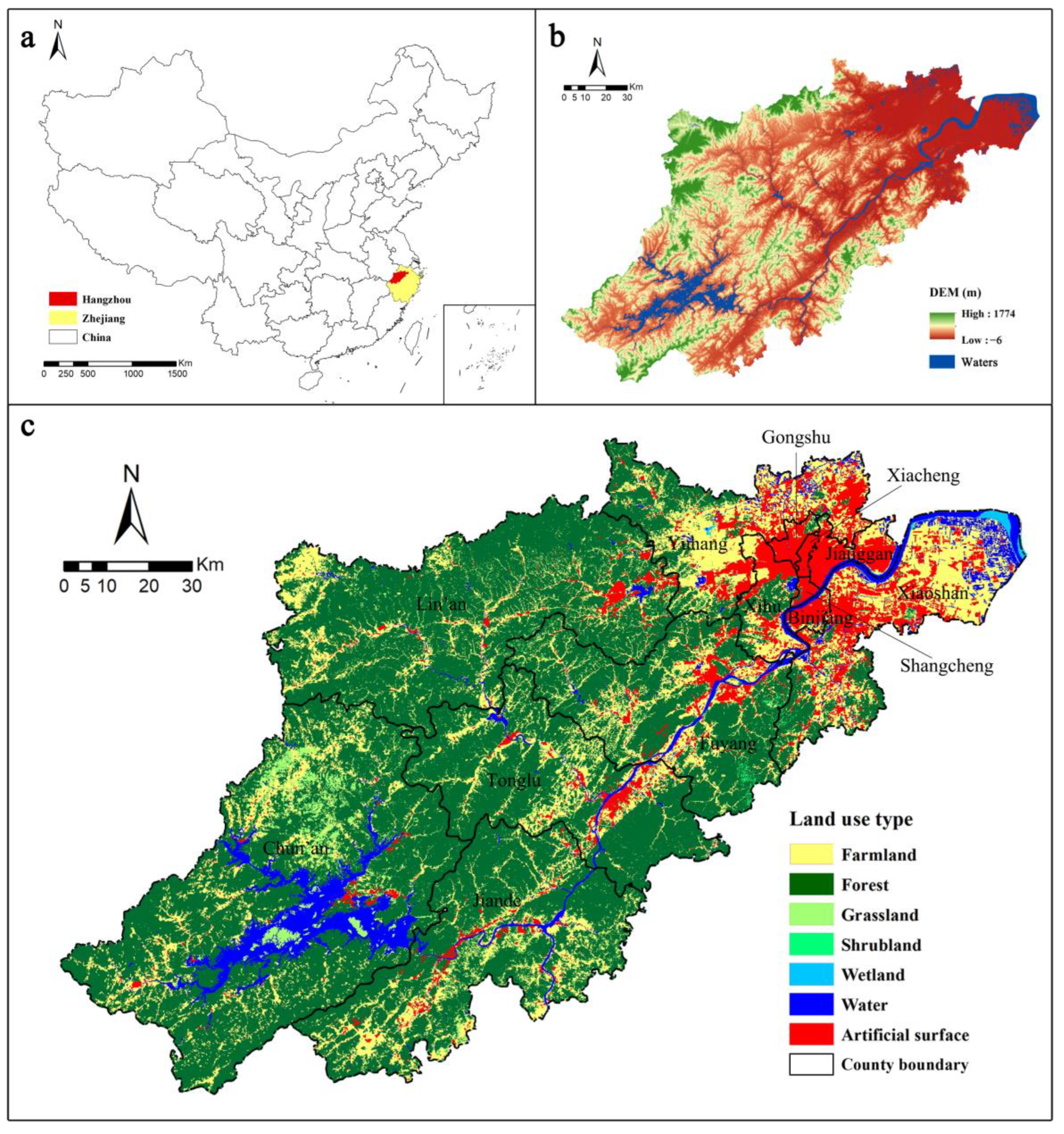
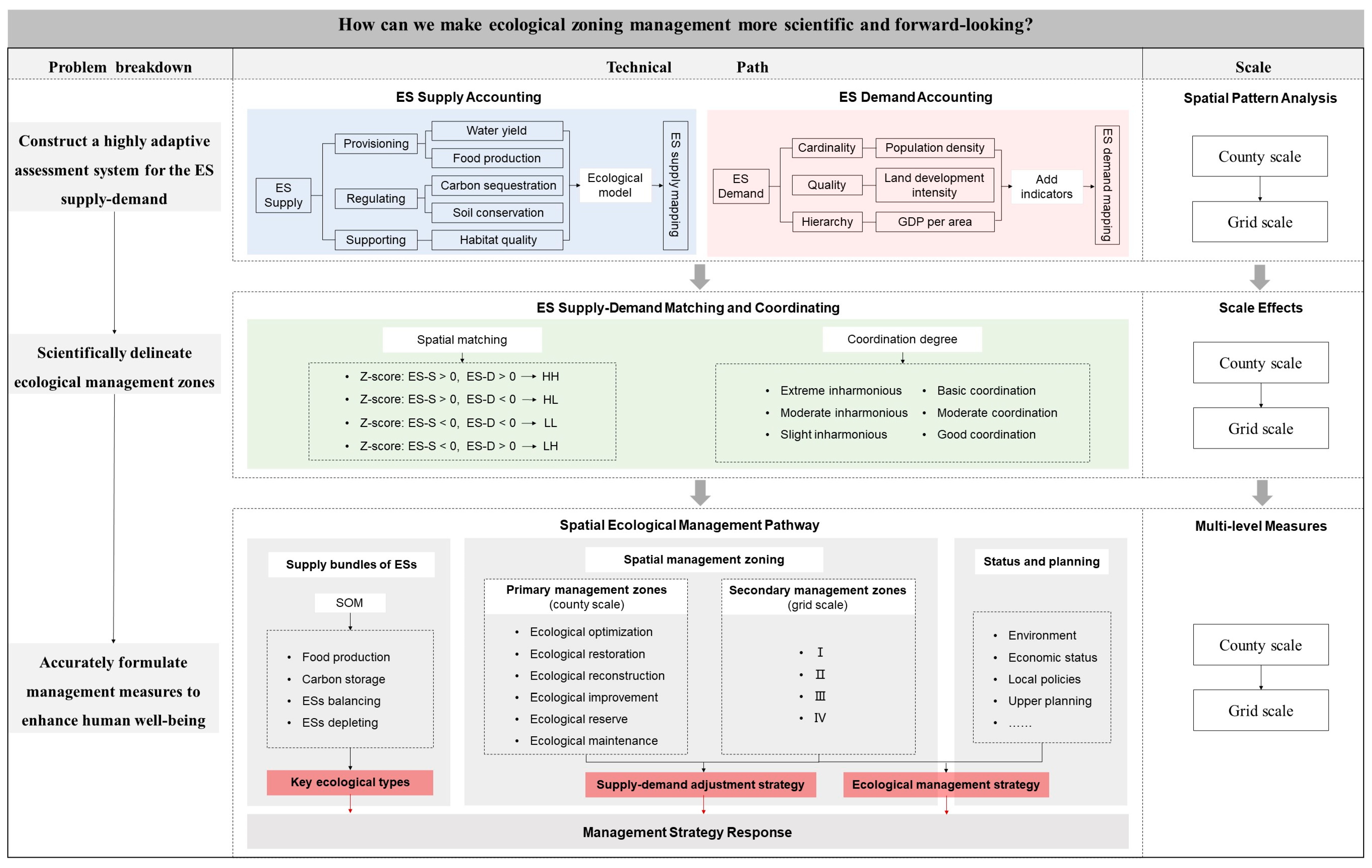
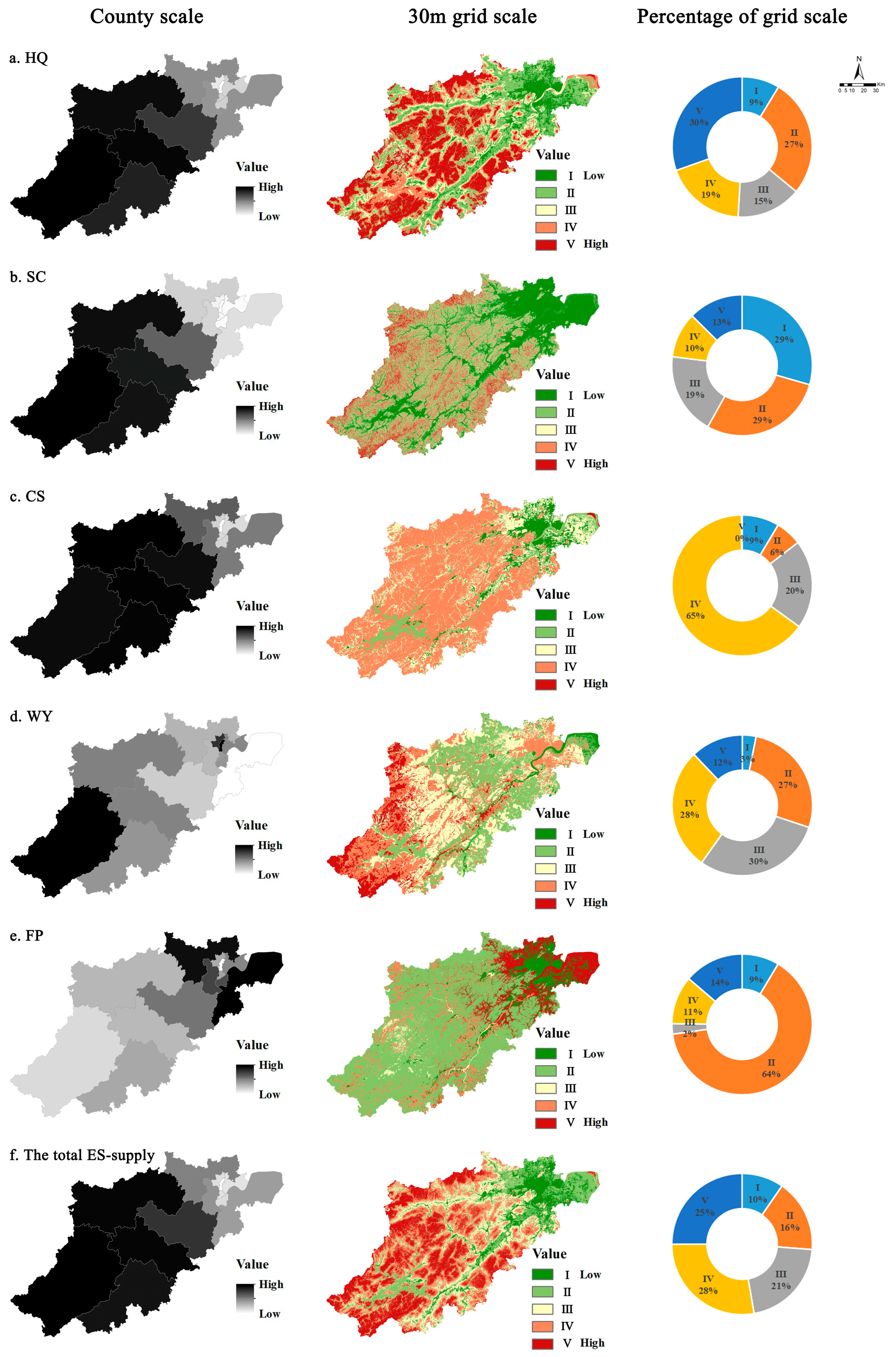
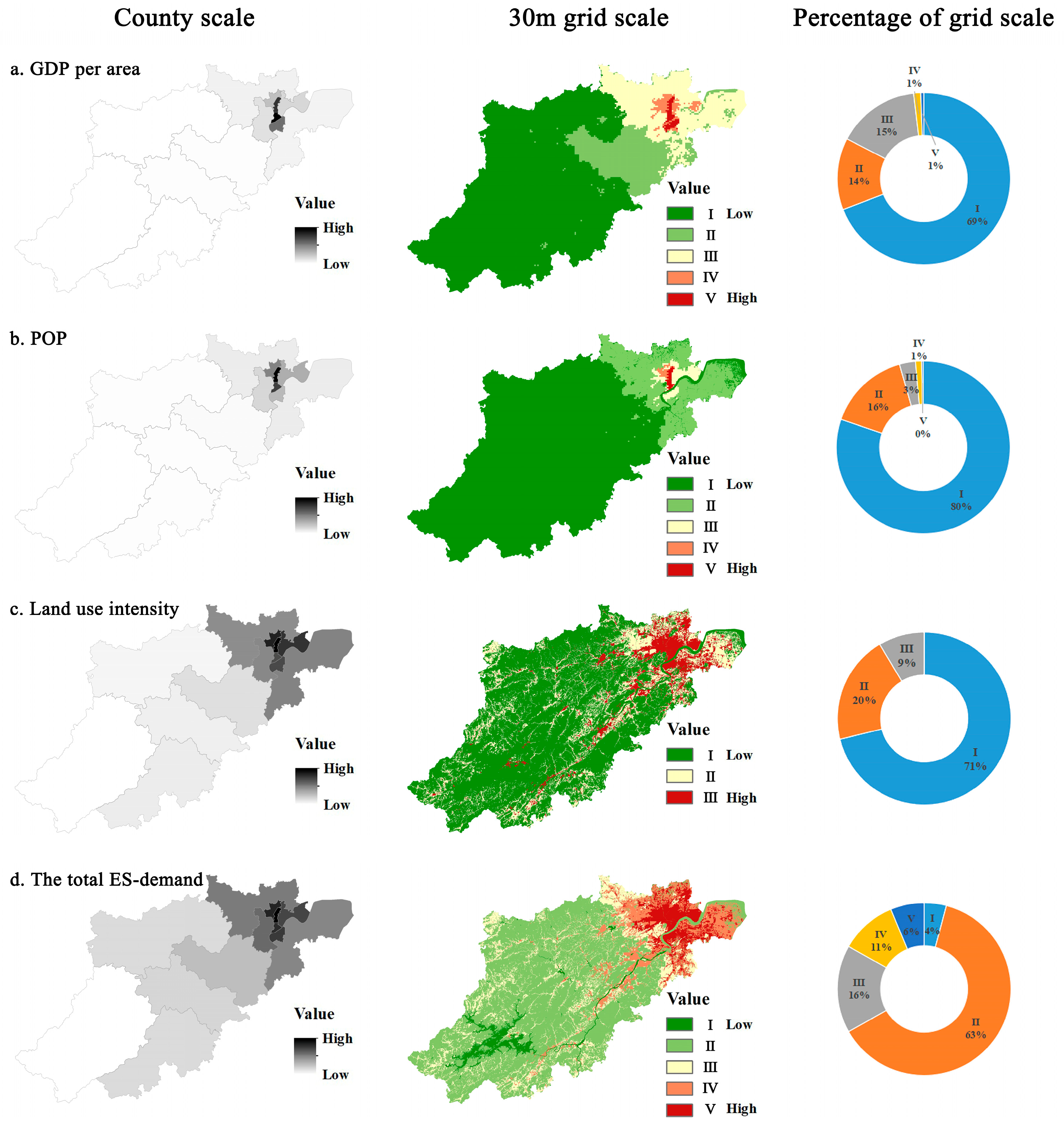
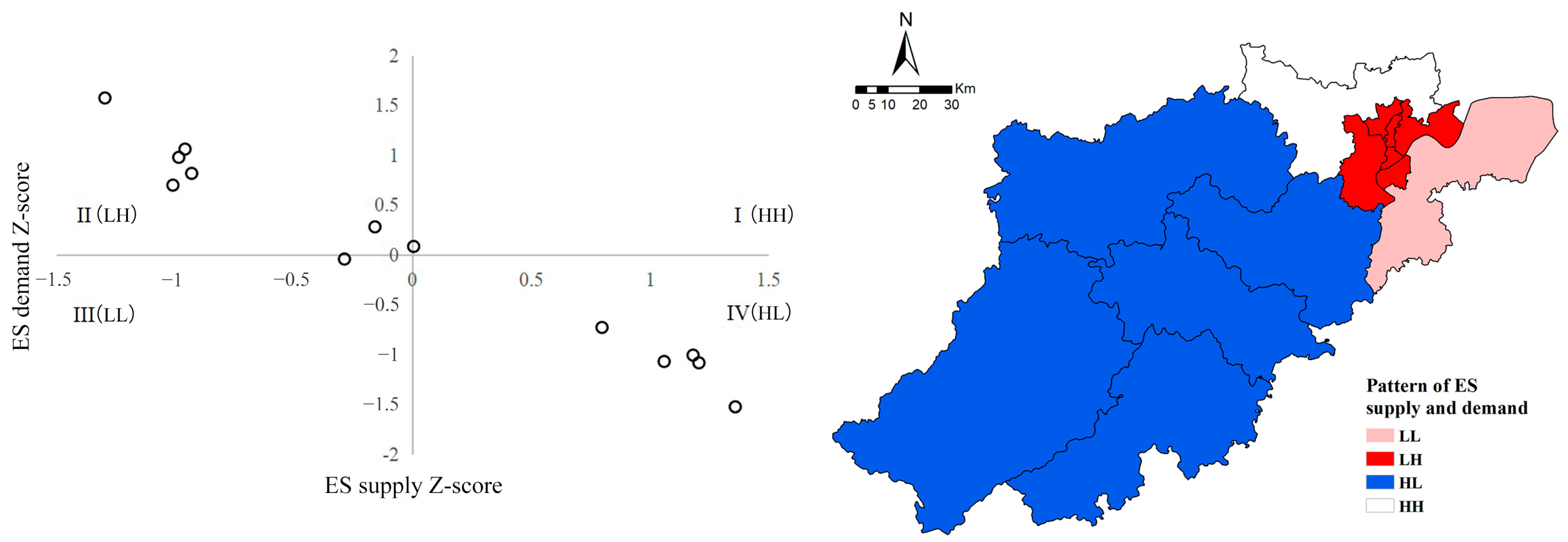
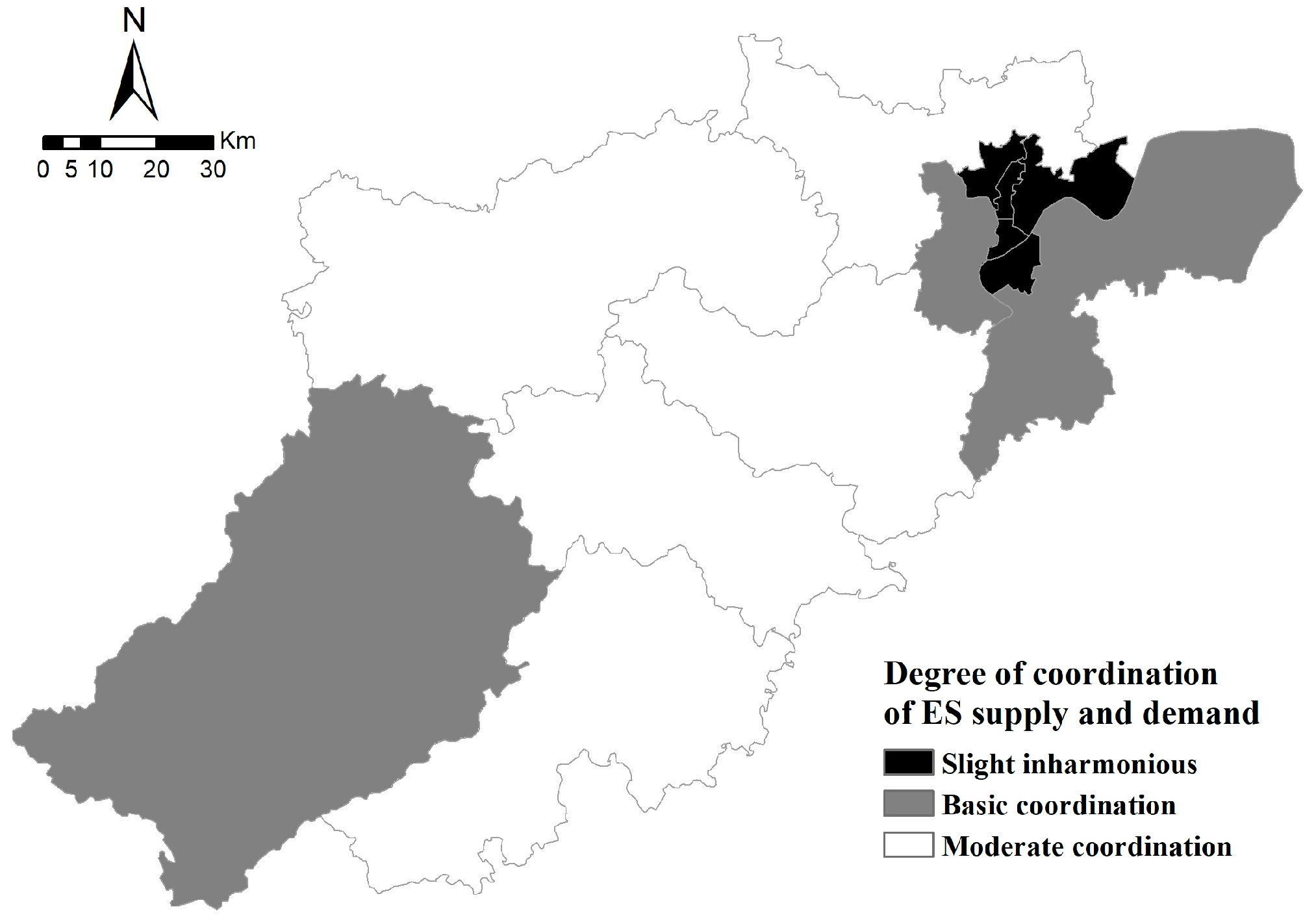
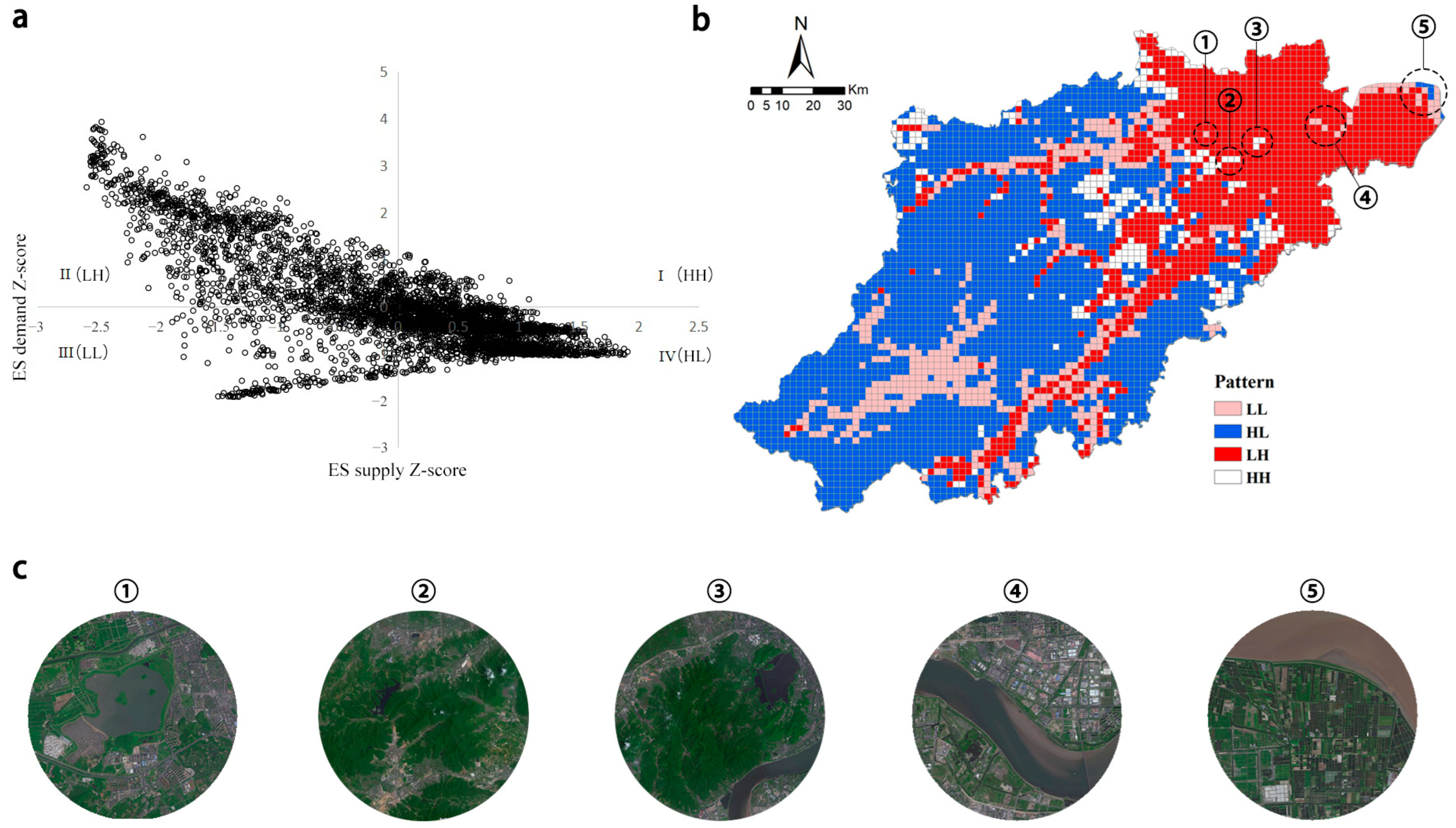

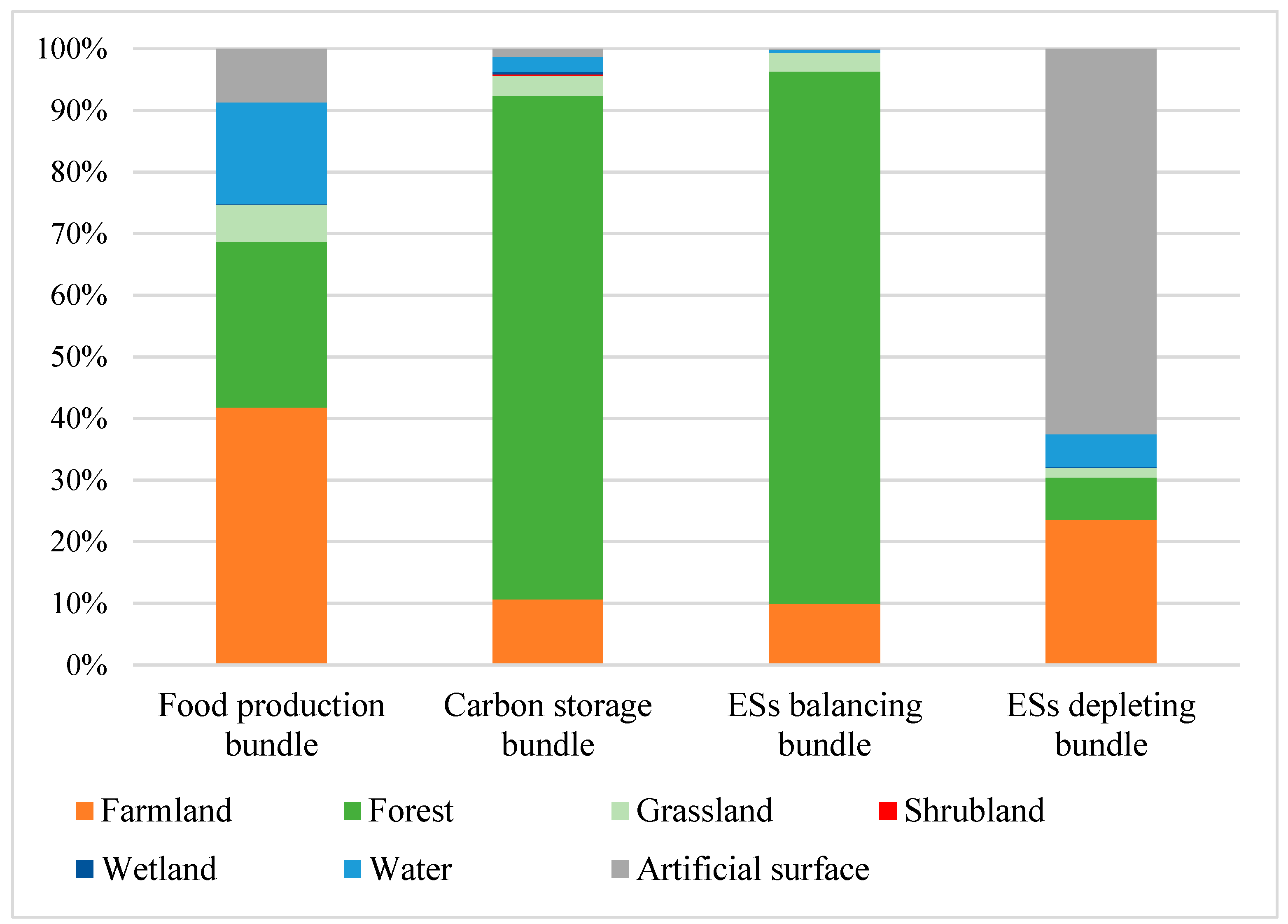

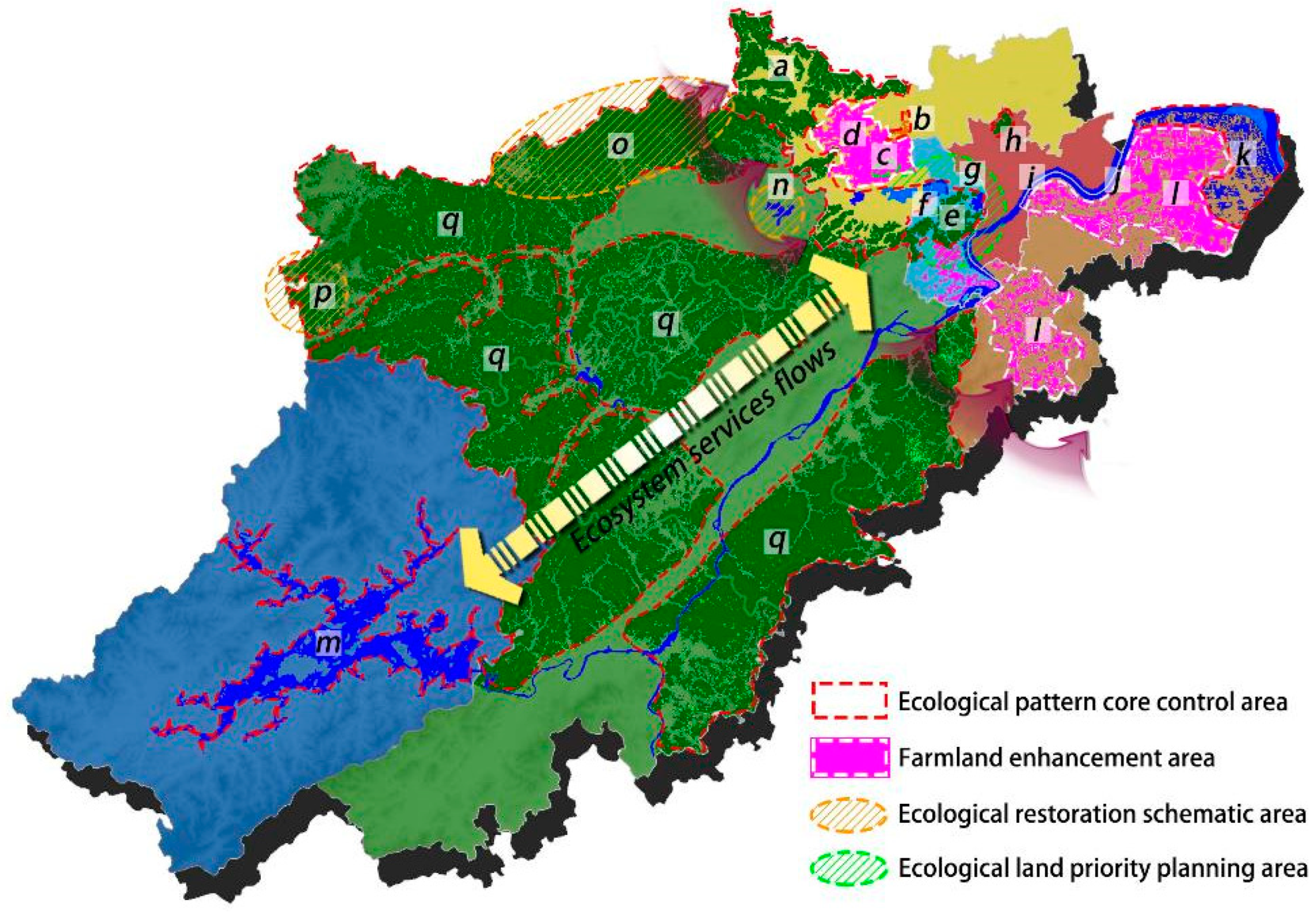
| Category | Data | Year | Resolution | Source |
|---|---|---|---|---|
| Raster data | Land cover data | 2020 | 30 m | http://www.globallandcover.com/ (accessed on 10 October 2022) |
| POP density | 2019 | 1 km | http://www.resdc.cn/ (accessed on 12 October 2022) | |
| GDP density | 2019 | 1 km | http://www.resdc.cn/ (accessed on 12 October 2022) | |
| Average annual precipitation (PRE) | 2001–2020 | 1 km | http://www.geodata.cn/ (accessed on 2 April 2023) | |
| Potential evapotranspiration (PET) | 2001–2020 | 1 km | http://www.geodata.cn/ (accessed on 2 April 2023) | |
| Pan-TPE soil map based on Harmonized World Soil Database V1.2 | - | 1 km | https://data.tpdc.ac.cn/ (accessed on 2 April 2023) | |
| Digital elevation model (DEM) | 2020 | 30 m | https://www.gscloud.cn/ (accessed on 2 April 2023) | |
| Depth-to-bedrock | 2020 | 1 km | [32] | |
| Vector data | Administrative boundaries | 2021 | - | https://www.webmap.cn/ (accessed on 25 March 2023) |
| Distance to main roads | 2020 | - | https://www.openstreetmap.org http://www.resdc.cn/ (accessed on 25 March 2023) | |
| Distance to minor roads | 2020 | - | https://www.openstreetmap.org http://www.resdc.cn/ (accessed on 25 March 2023) | |
| Distance to railroad | 2020 | - | https://www.openstreetmap.org http://www.resdc.cn/ (accessed on 25 March 2023) | |
| Distance to highway | 2020 | - | https://www.openstreetmap.org http://www.resdc.cn/ (accessed on 25 March 2023) | |
| Watershed spatial boundary | - | 30 arcsecond | https://www.hydrosheds.org/ (accessed on 17 April 2023) | |
| Statistical data | Economic output data | 2020 | https://www.hangzhou.gov.cn/ (accessed on 18 April 2023) |
| Threat | Maximum Distance of Influence (km) | Weight | Decay Type | Reference |
|---|---|---|---|---|
| Artificial surface | 6.0 | 0.8 | exponential | [38,39,40,41,42] |
| Farmland | 1.0 | 0.4 | linear | |
| Main roads | 5.0 | 0.7 | linear | |
| Minor roads | 2.0 | 0.5 | linear | |
| Highways | 4.0 | 0.6 | linear | |
| Railroads | 4.0 | 0.6 | linear |
| Land Use Type | Habitat | Artificial Surface | Farmland | Main Roads | Minor Roads | Highways | Railroads | Reference |
|---|---|---|---|---|---|---|---|---|
| Farmland | 0.4 | 0.7 | 0.0 | 0.6 | 0.5 | 0.5 | 0.6 | [38,39,40,41,42] |
| Forest | 0.9 | 0.9 | 0.7 | 0.8 | 0.7 | 0.8 | 0.8 | |
| Grassland | 0.6 | 0.9 | 0.6 | 0.8 | 0.7 | 0.7 | 0.8 | |
| Shrubland | 0.8 | 0.9 | 0.6 | 0.8 | 0.7 | 0.7 | 0.8 | |
| Wetland | 0.8 | 0.8 | 0.5 | 0.6 | 0.5 | 0.7 | 0.7 | |
| Water | 0.7 | 0.7 | 0.4 | 0.5 | 0.4 | 0.6 | 0.6 | |
| Artificial surface | 0.0 | 0.0 | 0.0 | 0.0 | 0.0 | 0.0 | 0.0 |
| Land Use Type | Crop Management Factor | Erosion Control Practice Factor | Reference |
|---|---|---|---|
| Farmland | 0.20 | 0.25 | [45,46] |
| Forest | 0.05 | 1.00 | |
| Grassland | 0.07 | 1.00 | |
| Shrubland | 0.06 | 1.00 | |
| Wetland | 0.00 | 0.00 | |
| Water | 0.00 | 0.00 | |
| Artificial surface | 0.92 | 1.00 |
| Land Use Type | Reference | ||||
|---|---|---|---|---|---|
| Farmland | 18.9 | 12.5 | 85.5 | 2.4 | [48,49,50,51] |
| Forest | 28.7 | 8.2 | 125.8 | 3.4 | |
| Grassland | 16.4 | 19.8 | 108.2 | 2.9 | |
| Shrubland | 8.1 | 1.6 | 91.7 | 3.5 | |
| Wetland | 7.4 | 24.3 | 247.8 | 1.2 | |
| Water | 0.1 | 0.0 | 64.0 | 0.0 | |
| Artificial surface | 0.8 | 0.1 | 52.6 | 0.0 |
| Land Use Type | Root Depth (mm) | Crop Coefficient | Vegetated or Not | Reference |
|---|---|---|---|---|
| Farmland | 2200 | 0.75 | 1 | [53] |
| Forest | 5200 | 0.98 | 1 | |
| Grassland | 2400 | 0.80 | 1 | |
| Shrubland | 5200 | 0.95 | 1 | |
| Wetland | 100 | 1.00 | 0 | |
| Water | 100 | 1.00 | 0 | |
| Artificial surface | 100 | 0.26 | 0 |
| Gross Output Value per Unit Area, (Million Yuan/km2) | Agriculture | Forestry | Animal Husbandry | Fisheries |
|---|---|---|---|---|
| Main urban area | 1004.87 | 149.71 | 5014.18 | 1106.99 |
| Tonglu | 769.84 | 41.07 | 938.44 | 435.95 |
| Chun’an | 653.57 | 24.27 | 203.11 | 53.87 |
| Jiande | 794.30 | 22.73 | 1443.66 | 377.21 |
| Fuyang | 1158.00 | 113.26 | 1476.65 | 772.14 |
| Lin’an | 678.67 | 91.79 | 1015.97 | 304.16 |
| Hangzhou City | 780.53 | 55.10 | 984.73 | 443.70 |
| Value | ≤0.2 | >0.2≤0.4 | >0.4≤0.5 | >0.5≤0.6 | >0.6≤0.8 | >0.8≤1.0 |
|---|---|---|---|---|---|---|
| Level | Extreme inharmonious | Moderate inharmonious | Slight inharmonious | Basic coordination | Moderate coordination | Good coordination |
| Match Type (County) | Degree of Coordination | Primary Ecological Management Zones | Counties (Major ES Types) | Overview of the Natural Environment and Economy | Match Type (Grid) | Secondary Ecological Management Zones |
|---|---|---|---|---|---|---|
| HH | Moderate coordination | Ecological optimization zones | Yuhang (FP) | Plain terrain, including the World Heritage-listed “China’s Archaeological Ruins of Liangzhu City”, with construction land, farmland, and forest land interspersed, and several abandoned mines. Now dominated by the digital economy. | HH | I |
| LH | II | |||||
| LL | IV | |||||
| LH | Basic coordination | Ecological restoration zones | Xihu (HQ, CS, FP) | Plain terrain, including the national 5A-level tourist attractions of Hangzhou West Lake Scenic Area, the national wetland park of Xixi Wetland, and Wuchao Mountain National Forest Park on the border with Yuhang and Fuyang. Highly urbanized area, densely populated. Dominated by high-tech industries and tourism. | HH | I |
| LH | II | |||||
| LL | IV | |||||
| Slight inharmonious | Ecological reconstruction zones | Shangcheng, Xiacheng, Binjiang, Gongshu, Jianggan | Plain terrain, including Banshan National Forest Park. A highly urbanized area with a high intensity of land development and dense population. Dominated by the digital economy, manufacturing industry, modern service industries, etc. | LH | II | |
| LL | IV | |||||
| LL | Basic coordination | Ecological improvement zones | Xiaoshan (FP) | Plain terrain, including the estuary of the Qiantang River, more arable land in the north, and more forested land in the south. Dominated by manufacturing, trade, and e-commerce industries mainly. | HH | I |
| LH | II | |||||
| HL | III | |||||
| LL | IV | |||||
| HL | Basic coordination | Ecological reserve zones | Chun’an (HQ, SC, CS, WY, FP) | Hilly, high elevation, with Qiandao Lake (580 km2, containing a national aquatic germplasm resource reserve). Dominated by tourism and eco-industry. | LH | II |
| LL | III | |||||
| HL | IV | |||||
| Moderate coordination | Ecological maintenance zones | Lin’an, Fuyang, Tonglu, Jiande (HQ, CS, FP) | Hilly, complex terrain; Lin’an contains a national nature reserve of Tianmu Mountain Nature Reserve. Dominated by agriculture and service industries. | HH | I | |
| LH | II | |||||
| HL | IV | |||||
| LL | III |
Disclaimer/Publisher’s Note: The statements, opinions and data contained in all publications are solely those of the individual author(s) and contributor(s) and not of MDPI and/or the editor(s). MDPI and/or the editor(s) disclaim responsibility for any injury to people or property resulting from any ideas, methods, instructions or products referred to in the content. |
© 2024 by the authors. Licensee MDPI, Basel, Switzerland. This article is an open access article distributed under the terms and conditions of the Creative Commons Attribution (CC BY) license (https://creativecommons.org/licenses/by/4.0/).
Share and Cite
Li, Y.; Ding, X.; Yao, S.; Zhang, B.; Jiang, H.; Zhang, J.; Liu, X. Multiscale Ecological Zoning Management with Coupled Ecosystem Service Bundles and Supply–Demand Balance, the Case of Hangzhou, China. Land 2024, 13, 360. https://doi.org/10.3390/land13030360
Li Y, Ding X, Yao S, Zhang B, Jiang H, Zhang J, Liu X. Multiscale Ecological Zoning Management with Coupled Ecosystem Service Bundles and Supply–Demand Balance, the Case of Hangzhou, China. Land. 2024; 13(3):360. https://doi.org/10.3390/land13030360
Chicago/Turabian StyleLi, Yonghua, Xinyi Ding, Song Yao, Bo Zhang, Hezhou Jiang, Junshen Zhang, and Xinwei Liu. 2024. "Multiscale Ecological Zoning Management with Coupled Ecosystem Service Bundles and Supply–Demand Balance, the Case of Hangzhou, China" Land 13, no. 3: 360. https://doi.org/10.3390/land13030360
APA StyleLi, Y., Ding, X., Yao, S., Zhang, B., Jiang, H., Zhang, J., & Liu, X. (2024). Multiscale Ecological Zoning Management with Coupled Ecosystem Service Bundles and Supply–Demand Balance, the Case of Hangzhou, China. Land, 13(3), 360. https://doi.org/10.3390/land13030360






